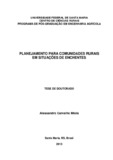| dc.creator | Miola, Alessandro Carvalho | |
| dc.date.accessioned | 2014-02-14 | |
| dc.date.available | 2014-02-14 | |
| dc.date.issued | 2013-02-26 | |
| dc.identifier.citation | MIOLA, Alessandro Carvalho. Planning for rural communities in situations of floods. 2013. 216 f. Tese (Doutorado em Engenharia Agrícola) - Universidade Federal de Santa Maria, Santa Maria, 2013. | por |
| dc.identifier.uri | http://repositorio.ufsm.br/handle/1/3607 | |
| dc.description.abstract | This thesis researched, in a watershed typically rural, ways to prevent the lack of mobility of the population, during and after flood events. Studies have also demonstrated the feasibility of developing a system to support civil defense, able to indicate safe areas from flooding scenarios, based on past occurrences. Floods happen when rainfall is extreme and triggers severe socioeconomic and environmental impacts, exacerbated by the lack of territorial planning-level watershed. The floods develop rapidly in space, especially in watersheds with headwaters in mountainous and downstream in floodplains. In such conditions, the rural population needs to be prepared as early as possible because the damage is aggravated by flooding or disruption on roads galleries and bridges. The method considered the stretches of roads that have been submerged, bridges, culverts, slabs, pencil bridges as well as those sites near the streams that were disrupted or blocked by the force of the current floods in the past. In these places the water left marks that were georeferenced and topographically leveled. This allowed delineate areas of flooding and correlate them to their cause rains recorded during the last fifty years. This approach allowed spatially simulate the effects of extreme rainfall, with intensities similar to those that have caused damage on the rural road network and thereby spatialize locations and sections of roads that can be submerged. Also identified strategic locations to monitor the level of water courses - the bridges. These locations were obtained odds of flooding that occurred in the last decade that have been applied in the adjustment of simulated inundation areas. The system has integrated the physical data of the basin, the delineation of wetlands and time series of precipitation and produced strategic information in situations of floods and flooding in a pilot basin in the Central Region of Rio Grande do Sul, confirming that its methodology fits the reality of rural watersheds. | eng |
| dc.description.sponsorship | Coordenação de Aperfeiçoamento de Pessoal de Nível Superior | |
| dc.format | application/pdf | por |
| dc.language | por | por |
| dc.publisher | Universidade Federal de Santa Maria | por |
| dc.rights | Acesso Aberto | por |
| dc.subject | Enchentes | por |
| dc.subject | Geoprocessamento | por |
| dc.subject | Microbacias | por |
| dc.subject | Mobilidade rural | por |
| dc.subject | Floods | eng |
| dc.subject | GIS | eng |
| dc.subject | Watershed | eng |
| dc.subject | Rural mobility | eng |
| dc.title | Planejamento para comunidades rurais em situações de enchentes | por |
| dc.title.alternative | Planning for rural communities in situations of floods | eng |
| dc.type | Tese | por |
| dc.description.resumo | Esta tese pesquisou, em uma bacia hidrográfica tipicamente rural, meios de prevenir a falta de mobilidade da população, durante e após ocorrências de enchentes. Os estudos realizados também demonstraram a viabilidade de desenvolver um sistema de apoio à defesa civil, capaz de indicar áreas de segurança a partir de cenários de enchentes, baseados em ocorrências do passado. As enchentes acontecem quando a pluviosidade é extrema e desencadeia graves impactos socioeconômicos e ambientais, potencializados pela falta de planejamento territorial em nível de bacia hidrográfica. As enchentes desenvolvem-se rapidamente no espaço, principalmente em microbacias com nascentes em relevo montanhoso e jusantes em planícies aluviais. Em tais condições, a população rural necessita estar preparada com a maior antecedência possível, pois os danos são agravados por alagamentos nas estradas ou por rompimento de pontes e galerias. O método considerou os trechos de estradas que ficaram submersos, as pontes, os bueiros, as lajes, as pinguelas, bem como aqueles trechos próximos dos arroios, que foram rompidos ou obstruídos pela força da correnteza nas enchentes do passado. Nesses locais a água deixou marcas que foram georreferenciadas e niveladas topograficamente. Isso possibilitou delimitar as áreas de alagamento e correlacioná-las às suas chuvas causadoras, registradas durante os últimos cinquenta anos. Essa aproximação permitiu simular espacialmente os efeitos das chuvas extremas, com intensidades semelhantes àquelas que já causaram prejuízos sobre a rede viária rural e, com isso, espacializar os locais e trechos de estradas que podem ficar submersos. Permitiu também identificar locais estratégicos para monitorar o nível dos cursos de água as pontes. Nesses locais obtiveram-se as cotas de enchentes, ocorridas na última década, que foram aplicadas no ajuste de áreas de inundação simuladas. O sistema integrou aos dados físicos da bacia, a delimitação das áreas alagadas e a série histórica de precipitação e produziu informações estratégicas nas situações de enchentes e inundações em uma bacia piloto, na Região Central do Rio Grande do Sul, confirmando que sua metodologia adequa-se à realidade de bacias rurais. | por |
| dc.contributor.advisor1 | Silveira, Geraldo Lopes da | |
| dc.contributor.referee1 | Mendes, Carlos André Bulhões | |
| dc.contributor.referee1Lattes | http://lattes.cnpq.br/9618523381359186 | por |
| dc.contributor.referee2 | Dill, Paulo Roberto Jaques | |
| dc.contributor.referee2Lattes | http://lattes.cnpq.br/4253323933047125 | por |
| dc.contributor.referee3 | Nishijima, Toshio | |
| dc.contributor.referee3Lattes | http://lattes.cnpq.br/5427442140441172 | por |
| dc.contributor.referee4 | Trevisan, Mario Luiz | |
| dc.contributor.referee4Lattes | http://lattes.cnpq.br/5664274438056008 | por |
| dc.creator.Lattes | http://lattes.cnpq.br/6330335959668033 | por |
| dc.publisher.country | BR | por |
| dc.publisher.department | Engenharia Agrícola | por |
| dc.publisher.initials | UFSM | por |
| dc.publisher.program | Programa de Pós-Graduação em Engenharia Agrícola | por |
| dc.subject.cnpq | CNPQ::CIENCIAS AGRARIAS::ENGENHARIA AGRICOLA | por |


